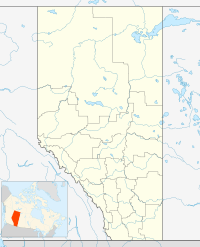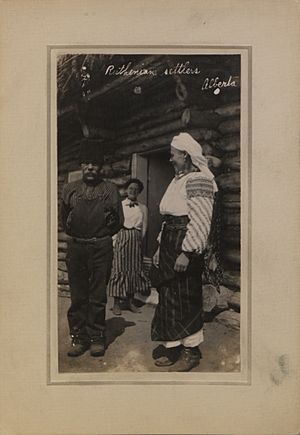Edna-Star colony facts for kids
The Edna-Star colony, also called the Nebyliv colony, is the biggest and oldest Ukrainian Canadian settlement in Canada. It's located east of Edmonton in Alberta. This area is very important to Ukrainian Canadian history and culture.
Contents
What is a Block Settlement?
A block settlement is a special type of rural community. It's where people from the same ethnic group live close together. You can find many of these in Western Canada. The Edna-Star colony was founded in 1891. This was the start of many Ukrainians coming to Canada. This area is as important to Ukrainian Canadian culture as Acadiana is to the Cajuns in Louisiana.
How the Colony Started
The idea for the colony began with Wasyl Eleniak. He was from a village called Nebyliv in Ukraine. He heard that people in Canada could get 160 acres of land for free. Wasyl's family had only a small amount of land. So, he decided to check out these rumors and move to Canada.
The colony was officially started by a group of Ukrainian settlers. They were led by Iwan Pylypow in 1891. Pylypow's first farm was near the village of Star, Alberta, which was then called Edna. That's why the area was later named Edna-Star.
Most of the first settlers came from Pylypow's home village of Nebyliv. Because of this, the area was sometimes called the Nebyliv colony. Later, more settlers came from other parts of Ukraine. These areas were mainly Galicia and Bukovina.
Why This Location Was Chosen
The settlers chose this location for a few reasons.
- There was already a German settlement nearby at Josephburg. Ukrainians in their home country were used to working with German neighbors. Many could even speak some German.
- New settlers needed to earn money. This helped them until their own farms could produce food. The German settlers were a good place to find work.
- Another important reason was the trees. This part of Alberta has many trees, unlike the open prairies further south. In Ukraine, wood was hard to get. Peasants depended on landlords for wood to build tools and homes. In Canada, they could get 160 acres of land, including forested land, for free. This was thanks to the Dominion Lands Act.
By 1914, the Ukrainian settlement area was very large. It stretched about 110 kilometers (68 miles) from Edna-Star in the west to Slawa in the east. It also went about 70 kilometers (43 miles) from Smoky Lake in the north to the edges of Mundare and Vegreville in the south.
Many other immigrants also came to this area. They were from the same parts of Ukraine as the Ukrainians. These groups included Poles, Romanians, Germans, and Jews.
Ukrainian Culture Today
Today, this area is known as the Kalyna Country ecomuseum. It works to keep Ukrainian Canadian culture alive. It's also home to the Ukrainian Cultural Heritage Village. This village has old pioneer buildings from all over the area.
At one time, up to 80% of the people in the settlement block were of Ukrainian origin. However, people have moved around Canada. This has changed the population patterns.
According to the 2006 Census, many people in this region still have Ukrainian roots. For example, in Alberta census division 10, about 20% of the population claimed some Ukrainian origin. In Division 12, it was around 19%.
Many people have moved from farms to cities. This is called rural-to-urban migration. Because of this, some smaller counties now have fewer people. This means their specific ethnic origin numbers are not always public.
The counties with the highest number of people claiming some Ukrainian origin include:
- County of St. Paul No. 19 (26%)
- Sturgeon County (18%)
- Beaver County (16%)
- Municipal District of Bonnyville No. 87 (17%)
- County of Vermilion River (16%)
Besides Ukrainians, other large groups in this area are French, German, Native Indian, and Metis. There are also smaller numbers of English, Scottish, Irish, Romanian, Polish, Russian, Jewish, and Norwegian people.
In the three largest towns in the region, the percentage of people with some Ukrainian origin was:
- Vegreville: 44%
- St. Paul: 31%
- Bonnyville: 18%
Other towns and villages with many Ukrainian people include Myrnam, Willingdon, Lamont, Mundare, Andrew, and Chipman. There are also many smaller communities.



